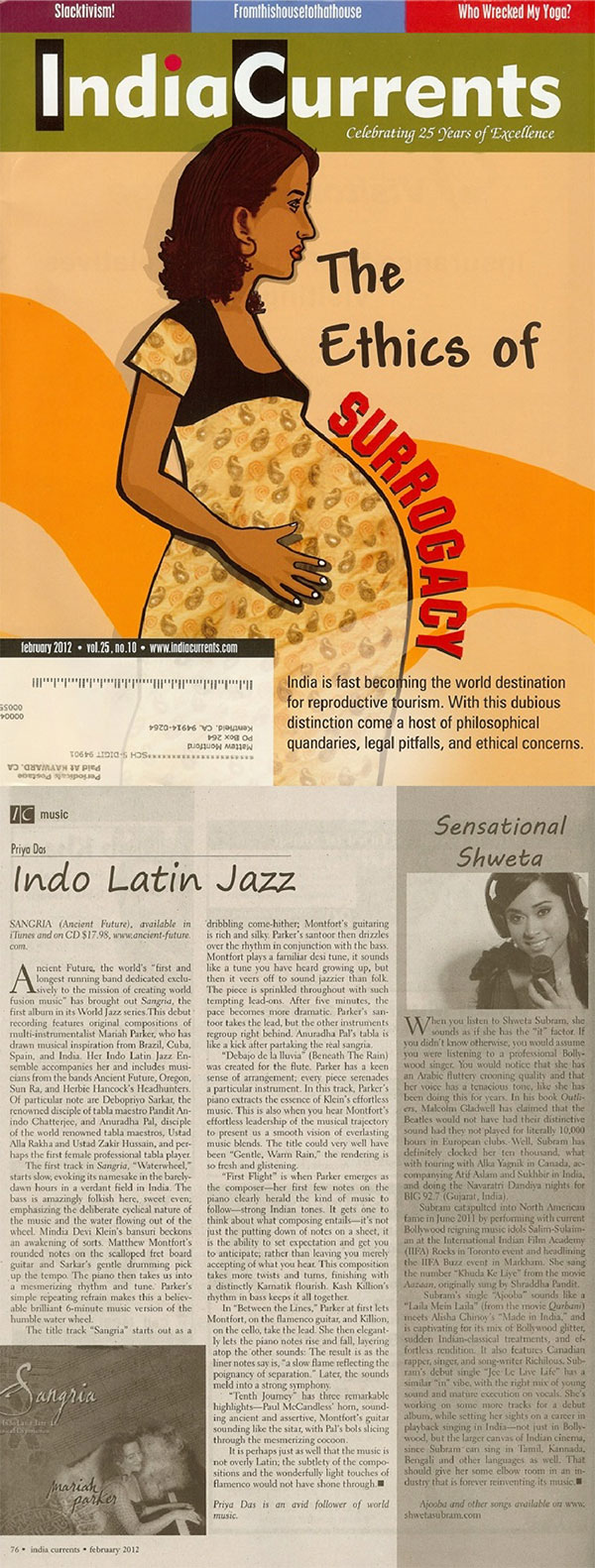 Ancient Future, the world’s “first and longest running band dedicated exclusively to the mission of creating world fusion music” has brought out Sangria, the first album in its World Jazz series.This debut recording features original compositions of multi-instrumentalist Mariah Parker, who has drawn musical inspiration from Brazil, Cuba, Spain, and India. Her Indo Latin Jazz Ensemble accompanies her and includes musicians from the bands Ancient Future, Oregon, Sun Ra, and Herbie Hancock’s Headhunters. Of particular note are Debopriyo Sarkar, the renowned disciple of tabla maestro Pandit Anindo Chatterjee, and Anuradha Pal, disciple of the world renowned tabla maestros, Ustad Alla Rakha and Ustad Zakir Hussain, and perhaps the first female professional tabla player.
Ancient Future, the world’s “first and longest running band dedicated exclusively to the mission of creating world fusion music” has brought out Sangria, the first album in its World Jazz series.This debut recording features original compositions of multi-instrumentalist Mariah Parker, who has drawn musical inspiration from Brazil, Cuba, Spain, and India. Her Indo Latin Jazz Ensemble accompanies her and includes musicians from the bands Ancient Future, Oregon, Sun Ra, and Herbie Hancock’s Headhunters. Of particular note are Debopriyo Sarkar, the renowned disciple of tabla maestro Pandit Anindo Chatterjee, and Anuradha Pal, disciple of the world renowned tabla maestros, Ustad Alla Rakha and Ustad Zakir Hussain, and perhaps the first female professional tabla player.
The first track in Sangria, “Waterwheel,” starts slow, evoking its namesake in the barely-dawn hours in a verdant field in India. The bass is amazingly folkish here, sweet even; emphasizing the deliberate cyclical nature of the music and the water flowing out of the wheel. Mindia Devi Klein’s bansuri beckons an awakening of sorts. Matthew Montfort’s rounded notes on the scalloped fret board guitar and Sarkar’s gentle drumming pick up the tempo. The piano then takes us into a mesmerizing rhythm and tune. Parker’s simple repeating refrain makes this a believable brilliant 6-minute music version of the humble water wheel.
The title track “Sangria” starts out as a come-hither; Montfort’s guitaring is rich and silky. Parker’s santoor then drizzles over the rhythm in conjunction with the bass. Montfort plays a familiar desi tune, it sounds like a tune you have heard growing up, but then it veers off to sound jazzier than folk. The piece is sprinkled throughout with such tempting lead-ons. After five minutes, the pace becomes more dramatic. Parker’s santoor takes the lead, but the other instruments regroup right behind. Anuradha Pal’s tabla is like a kick after partaking the real sangria.
“Debajo de la lluvia” (Beneath The Rain) was created for the flute. Parker has a keen sense of arrangement; every piece serenades a particular instrument. In this track, Parker’s piano extracts the essence of Klein’s effortless music. This is also when you hear Montfort’s effortless leadership of the musical trajectory to present us a smooth vision of everlasting music blends. The title could very well have been “Gentle, Warm Rain,” the rendering is so fresh and glistening.
“First Flight” is when Parker emerges as the composer—her first few notes on the piano clearly herald the kind of music to follow—strong Indian tones. It gets one to think about what composing entails—it’s not just the putting down of notes on a sheet, it is the ability to set expectation and get you to anticipate; rather than leaving you merely accepting of what you hear. This composition takes more twists and turns, finishing with a distinctly Karnatik flourish. Kash Killion’s rhythm in bass keeps it all together.
In “Between the Lines,” Parker at first lets Montfort, on the flamenco guitar, and Killion, on the cello, take the lead. She then elegantly lets the piano notes rise and fall, layering atop the other sounds: The result is as the liner notes say is, “a slow flame reflecting the poignancy of separation.” Later, the sounds meld into a strong symphony.
“Tenth Journey” has three remarkable highlights—Paul McCandless’ horn, sounding ancient and assertive, Montfort’s guitar sounding like the sitar, with Pal’s bols slicing through the mesmerizing cocoon.
It is perhaps just as well that the music is not overly Latin; the subtlety of the compositions and the wonderfully light touches of flamenco would not have shone through.